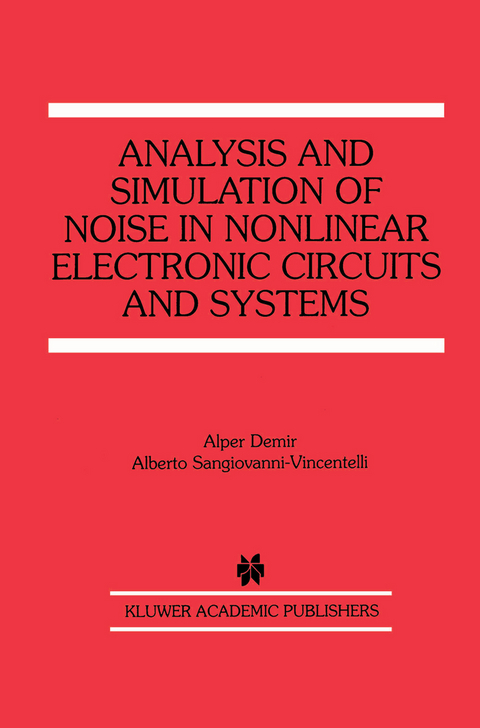
Analysis and Simulation of Noise in Nonlinear Electronic Circuits and Systems
Springer-Verlag New York Inc.
978-1-4613-7777-1 (ISBN)
In electronic circuit and system design, the word noise is used to refer to any undesired excitation on the system. In other contexts, noise is also used to refer to signals or excitations which exhibit chaotic or random behavior. The source of noise can be either internal or external to the system. For instance, the thermal and shot noise generated within integrated circuit devices are in ternal noise sources, and the noise picked up from the environment through electromagnetic interference is an external one. Electromagnetic interference can also occur between different components of the same system. In integrated circuits (Ies), signals in one part of the system can propagate to the other parts of the same system through electromagnetic coupling, power supply lines and the Ie substrate. For instance, in a mixed-signal Ie, the switching activity in the digital parts of the circuit can adversely affect the performance of the analog section of the circuit by traveling through the power supply lines and the substrate. Prediction of the effect of these noise sources on the performance of an electronic system is called noise analysis or noise simulation. A methodology for the noise analysis or simulation of an electronic system usually has the following four components: 2 NOISE IN NONLINEAR ELECTRONIC CIRCUITS • Mathematical representations or models for the noise sources. • Mathematical model or representation for the system that is under the in fluence of the noise sources.
1. Introduction.- 2. Mathematical Background.- 2.1 Probability and Random Variables.- 2.2 Stochastic Processes.- 2.3 Filtering of Stochastic Processes with Linear Transformations.- 2.4 Matrix Algebra, Linear Differential Equations and Floquet Theory.- 2.5 Stochastic Differential Equations and Systems.- 3. Noise Models.- 3.1 Physical Origins of Electrical Noise.- 3.2 Model for Shot Noise as a Stochastic Process.- 3.3 Model for Thermal Noise as a Stochastic Process.- 3.4 Models for Correlated or non-White Noise.- 3.5 Summary.- 4. Overview of Noise Simulation for Nonlinear Electronic Circuits.- 4.1 Overview.- 4.2 Noise Simulation with LTI Transformations.- 4.3 Noise Simulation with LPTV Transformations.- 4.4 Monte Carlo Noise Simulation with Direct Numerical Integration.- 4.5 Summary.- 5. Time-Domain Non-Monte Carlo Noise Simulation.- 5.1 Formulation of Circuit Equations with Noise.- 5.2 Probabilistic Characterization of the Circuit with Noise.- 5.3 Small Noise Expansion.- 5.4 Derivation of a Linear Time Varying SDE Model for Noise Analysis.- 5.5 Derivation of Linear Time Varying ODEs for the Autocorrelation Matrix.- 5.6 Solution of the Linear Time Varying ODEs for the Autocorrelation Matrix.- 5.7 Numerical Computation of the Autocorrelation Matrix.- 5.8 Alternative ODEs for the Autocorrelation Matrix.- 5.9 Time-Invariant and Periodic Steady-State.- 5.10 Examples.- 5.11 Summary.- 6. Noise in Free Running Oscillators.- 6.1 Phase Noise and Timing Jitter Concepts.- 6.2 Phase Noise Characterization with Time Domain Noise Simulation.- 6.3 Phase Noise: Same at All Nodes.- 6.4 Kaertner’s Work on Phase Noise.- 6.5 Alternative Phase Noise Characterization Algorithm.- 6.6 Non-White Noise Sources and Phase Noise.- 6.7 Phase Noise of Phase-Locked Loops.- 6.8 Summary.- 7. BehavioralModeling and Simulation of Phase-Locked Loops.- 7.1 PLLs for Clock Generators and Frequency Synthesizers.- 7.2 Behavioral Models of PLL Components.- 7.3 Behavioral Simulation Algorithm.- 7.4 Post Processing for Spurious Tones and Timing Jitter/Phase Noise.- 7.5 Examples.- 7.6 Summary.- 8. Conclusions and Future Work.- References.- Index>.
| Erscheint lt. Verlag | 2.11.2012 |
|---|---|
| Reihe/Serie | The Springer International Series in Engineering and Computer Science ; 425 |
| Zusatzinfo | IX, 275 p. |
| Verlagsort | New York, NY |
| Sprache | englisch |
| Maße | 155 x 235 mm |
| Themenwelt | Informatik ► Weitere Themen ► CAD-Programme |
| Technik ► Elektrotechnik / Energietechnik | |
| Technik ► Nachrichtentechnik | |
| ISBN-10 | 1-4613-7777-3 / 1461377773 |
| ISBN-13 | 978-1-4613-7777-1 / 9781461377771 |
| Zustand | Neuware |
| Informationen gemäß Produktsicherheitsverordnung (GPSR) | |
| Haben Sie eine Frage zum Produkt? |
aus dem Bereich


